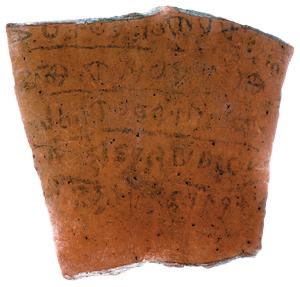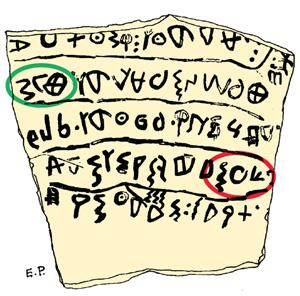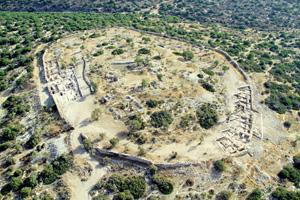Ancient Inscription Refers to Birth of Israelite Monarchy
Gerard Leval
Source - http://www.bib-arch.org/bar/article.asp?PubID=BSBA&Volume=38&Issue=03&ArticleID=04&Page=1&UserID=0&

The already famous Qeiyafa Ostracon, found only in 2008, has been read and interpreted quite differently by a variety of senior scholars, as recounted in the previous article by Christopher Rollston. One of the most fascinating interpretations is by Émile Puech, the senior epigrapher of the prestigious École Biblique et Archéologique Française in Jerusalem. Because his analysis is written in French (published in the Revue Biblique1), it is not well known outside of a small group of scholars, but it is well worth considering. In Puech’s view, the Qeiyafa Ostracon is the earliest known text relating to the establishment of the Israelite monarchy—likely referring to the installation of the first Israelite king, Saul, rather than to the accession to that throne by his more illustrious successor David.
The five-line text of the ostracon, written in ink on the inside of a broken piece of pottery from a large jar, is badly abraded and, Puech agrees, cannot be deciphered with certainty. Some portions of the text are simply missing,2 and the legible letters are very irregularly written and positioned. Just as Rollston proposes in the previous article, Puech reads the text from left-to-right, rather than in the more common Hebrew direction of right-to-left. From the sloping of the text, he deduces that the scribe held the potsherd in his left hand, and he notes that the text is slightly tilted up to the right.
Puech rejects the notion put forward by some that the text is just a writing exercise by a scribe.3Rather, he posits that the text is the concluding section of an administrative document and proposes the following interpretation of the five-line text:

Do not oppress, and serve God … despoiled him/her
The judge and the widow wept; he had the power
over the resident alien and the child, he eliminated them together
The men and the chiefs/officers have established a king
He marked 60 [?] servants among the communities/habitations/generations4

Puech begins his analysis with an extensive examination of each letter and the way in which each is written—its direction, its proximity to adjacent letters, as well as its position within the line. He also explores various alternative interpretations of the text. Ultimately, he concludes that the message is “manifestly incomplete,”5 that it is only a part (albeit a substantial part) of a longer text. He assumes that the first part is entirely missing, but theorizes that the text is plausibly “a copy for the purpose of memorializing a message coming from elsewhere, the copy of an administrative circular.”6
According to Puech, the text appears to be the locally written copy of a message to the governor or a notable of the town, informing him of the decisions taken by a hierarchical superior (the king or a minister of the central administration). The text directs the recipient faithfully to accept those decisions, in his comportment and in regulating local situations, and, in particular, in matters dealing with the needy, the widow, the resident alien and children, in contrast to that which was done previously.7
The text is thus a message to a local leader about decisions taken by someone in a higher position of authority, which the recipient must accept.
The text provides insights into “the organization of society in connection with the exercise of government and of local justice.”8 It identifies concerns about “the manner of rendering justice, which was not in conformity with that which is expected of judges.”9
Finally, and most importantly, the text informs us (in line 4) about the “establishment of a monarchy, an experience that is apparently new,” according to Puech, and thus not likely the result of a succession within an established monarchical line.10
Each of these bits of information is significant in itself, but together they provide a powerful confirmation of a major political transformation.11
Puech dates the ostracon to “about 1000 B.C.E., toward the end of the 11th century or more probably the beginning of the tenth century B.C.E.”12 In his judgment, based on the shape and form of the letters, the Qeiyafa inscription is “certainly” older than the Gezer Calendar and the Tel Zayit Abecedary,13 two other inscriptions treated in the preceding article by Christopher Rollston.
In archaeological terms, this is the period denominated Iron Age IIA, the time of the earliest kingdom of Israel, not that of David and Solomon, but even earlier, that of King Saul.
Puech notes that others have concluded that the language of the text is Hebrew and have asserted that it is the “oldest Hebrew text—found in an Israelite or Judahite fortress.”14 Puech recognizes, however, that at this stage it remains impossible to distinguish completely between Hebrew and Canaanite.15 That the ostracon was found in an Israelite fortress (which is devoid of any remnants of pig bones commonly found in the same strata of archeological sites of Philistine cities) would tend to reinforce the possibility that it may be Hebrew.16
Who is the king referred to in line 4? The use of the word “established” seems to indicate that the king ascended to the throne by the establishment of his monarchy rather than by familial succession. Given the provenance of the find—a Judahite fortress—only two possibilities seem available: David or Saul. Puech leans toward Saul—the first Israelite king.
According to the Bible, Saul was chosen by the high priest Samuel to rule over the Israelites. Saul, who, together with three of his sons, died on the battlefield at Mt. Gilboa, was not succeeded on the Israelite throne by any of his descendants, but by David the son of Jesse of the tribe of Judah. Puech dates the beginning of Saul’s reign to approximately 1030 B.C.E., and David’s to approximately 1010 B.C.E.
The Biblical text informs us that Samuel’s sons did not follow in their father’s ways. They accepted bribes and perverted justice. As a consequence, the elders approached the aging Samuel and demanded that he appoint a king over Israel. At first Samuel resisted; however, the text states that in the end the Lord instructed Samuel to accede to the elders’ demand and guided him to Saul, the tall, handsome son of Kish of the tribe of Benjamin, who became Israel’s first king (1 Samuel 8–9).
Puech tells us that when he had completed deciphering the text of the Qeiyafa Ostracon, he was “surprised to find that [it] contained all of the essentials” that are in the Biblical text:17 (1) the need for judges who will not oppress the foreigner and those less fortunate (e.g., the widow and the orphan) and a need for those who will protect them from annihilation, (2) the installation of a king, (3) the existence of servants who serve the king, (4) the injunction not to oppress, but to serve God and (5) most importantly the designation of a new monarch.
For Puech, the text announces the installation of a centralized royal administration and it makes this announcement to a distant frontier province. He concedes that it is difficult to establish with certainty whether the new royal administration is that of Saul or David. On balance, however, he concludes that, most likely, the ostracon refers to Saul’s accession.
Puech agrees with the excavators that Khirbet Qeiyafa is likely Biblical Shaarayim. Shaarayim is located in Judah, and Qeiyafa seems to be located in an area where the Bible places Shaarayim (Joshua 15:36). The name Shaarayim means “gates”; Qeiyafa is a prime contender for Shaarayim since it has two gates, while other sites excavated in the vicinity have only one gate.a
Another Biblical reference to Shaarayim indicates it existed before the time of David’s reign: After David killed the Philistine Goliath with a stone flung using his slingshot and then beheaded the giant with Goliath’s own sword, the Israelites pursued the Philistines who fell mortally wounded on the way from Shaarayim (1 Samuel 17:52).
This reference reflects the existence of Shaarayim before David’s reign, during his predecessor Saul’s reign (see also 1 Chronicles 4:31). Since the Qeiyafa inscription refers to an apparently new king and seems to have been written earlier than David’s reign, Puech concludes that it is more likely that the ostracon refers to the establishment of Saul’s rule.
Moreover, the inscription seems to memorialize (or, in Puech’s words, is “a witness to”18) the transition not from one king to another (from Saul to David), but rather from the period of the judges to the monarchy—thus from Samuel and his sons to Saul.19
If Puech is correct, the Qeiyafa Ostracon is the only archaeological artifact referring to Israel’s first king. And it is the earliest non-Biblical confirmation of the establishment of the Israelite monarchy.